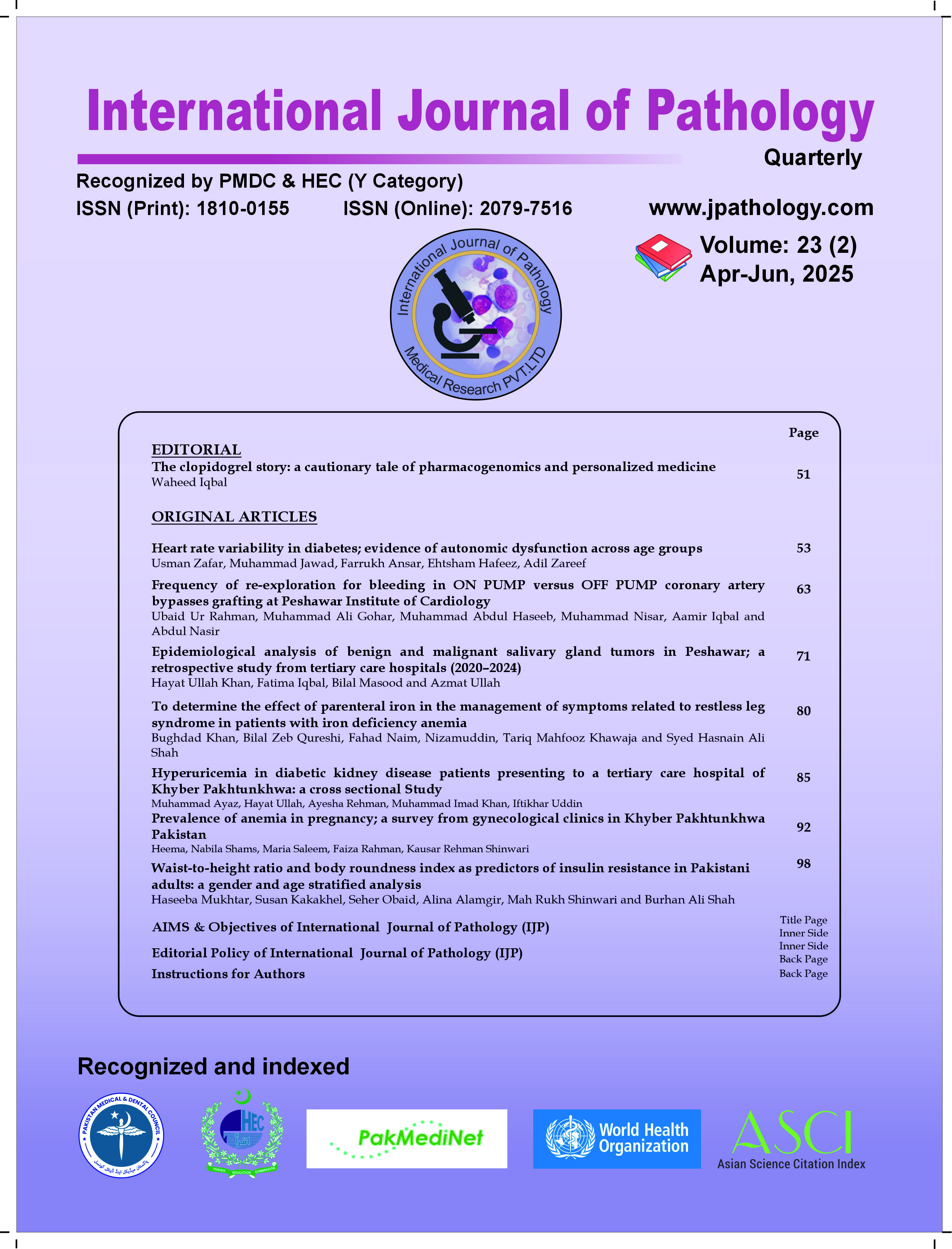Hyperuricemia in diabetic kidney disease patients presenting to a tertiary care hospital of Khyber Pakhtunkhwa
a cross sectional Study
DOI:
https://doi.org/10.59736/IJP.23.02.956Keywords:
Chronic Kidney Disease, Diabetes Mellitus, Diabetic Kidney Disease, Hyperuricemia, Uric AcidAbstract
Background: Hyperuricemia is commonly observed in patients with diabetic kidney disease (DKD) and is believed to contribute to worsening renal outcomes. Limited local data exist to highlight the burden of hyperuricemia in these patients in Pakistan. We want to determine the prevalence of hyperuricemia in patients with DKD presenting to a tertiary care hospital in Khyber Pakhtunkhwa.
Methods: This Descriptive cross-sectional study was conducted at the Nephrology unit of Lady Reading Hospital, Peshawar, from May to October 2024. A total of 237 patients having T2DM and chronic kidney disease were enrolled using non-probability consecutive sampling. DKD was defined as an estimated glomerular filtration rate (eGFR) <60 mL/min/1.73 m^2 and/or albuminuria >30 mg/g for more than 3 months. Hyperuricemia was characterized by serum uric acid concentrations above 7.0 mg/dL in males and 6.0 mg/dL in females. The data were analyzed using SPSS version 24, with a p-value of ≤ 0.05 considered statistically significant.
Results: Of the 237 participants, 127 (53.6%) were males and 110 (46.4%) females, with a mean age of 51 ± 9.02 years. Hyperuricemia was observed in 131 patients (55.3%). The condition was more prevalent in females than in males (p < 0.05). A significant association was noted between hyperuricemia and the duration of diabetic kidney disease.
Conclusion: Hyperuricemia is highly prevalent among diabetic kidney disease patients, affecting over half of the studied population. These findings underscore the need for routine screening and early intervention to potentially slow disease progression and reduce related complications.
References
Tuttle KR, Bakris GL, Bilous RW, Chiang JL, de Boer IH, Goldstein-Fuchs J, et al. Diabetic kidney disease: a report from an ADA consensus conference. Am J Kidney Dis. 2014;64(4):510–33.
American Diabetes Association. 10. Microvascular complications and foot care. Diabetes Care. 2023;46(Suppl 1):S135–51.
Alicic RZ, Rooney MT, Tuttle KR. Diabetic kidney disease: challenges, progress, and possibilities. Clin J Am Soc Nephrol. 2017;12(12):2032–45.
Duru OK, Middleton T, Tewari MK, Norris KC. The landscape of diabetic kidney disease in the United States. Curr Diab Rep. 2019;19(3):17.
Rossing P, Persson F, Frimodt-Møller M. Prognosis and treatment of diabetic nephropathy: recent advances and perspectives. Nephrol Ther. 2018;14(Suppl 1):S31–7.
Han Y, Ma W, He T, Song Z, Huang X, Gong S. Association of uric acid with diabetic kidney disease in patients with type 2 diabetes: a meta-analysis. BMC Endocr Disord. 2020;20(1):1.
Johnson RJ, Nakagawa T, Sanchez-Lozada LG, Shafiu M. Sugar, uric acid, and the etiology of diabetes and obesity. Diabetes. 2013;62(10):3307–15.
Kim IY, Kim JH, Kim MJ, Kwak H, Lee S, Lee Y, et al. Effect of uric acid lowering therapy on renal outcomes: a systematic review and meta-analysis. Am J Nephrol. 2020;51(5):372–87.
Liu P, Chen Y, Wang B, Zhang F. Dietary factors and the risk of hyperuricemia: meta-analysis and systematic review. Nutr Rev. 2018; 76(4):310–21.
Kodama S, Saito K, Yachi Y, Asumi M. Association between serum uric acid and development of type 2 diabetes. Diabetes Care. 2009; 32(9):1737–42.
Fox IH, Kelley WN. Studies on the mechanismof fructose-induced hyperuricemia in man. Metabolism. 1972; 21(8):713–21.
Kuwabara M, Borghi C, Cicero AFG, Jafar TH, Johnson RJ, Kang DH, et al. Elevated serum uric acid and cardiovascular disease: a narrative review. Heart. 2020;106(10):726–35.
Kanbay M, Jensen T, Solak Y, Le M. Uric acid in metabolic syndrome: from an innocent bystander to a central player. Eur J Intern Med. 2016; 29:3–8.
Kuwabara M. Hyperuricemia, cardiovascular disease, and hypertension. Pulse (Basel). 2016;3(3–4):242–52.
Shah N, Amanullah SJ, Marwat MA. Association of hyperuricemia with diabetic nephropathy in type 2 diabetes mellitus. Khyber J Med Sci. 2014; 7(2):267.
Gulzar A, Muhammad K, Muhammad A, Babar M, Imran DK, Muhammad T. Frequency of hyperuricemia in type-2 diabetes mellitus and its relation with diabetic nephropathy. Pak Armed Forces Med J. 2023; 73(1):199–203.
Qayyum M, Butt B, Khan G. Hyperuricemia in pre-dialysis chronic kidney disease patients: a single centre experience. Pak Armed Forces Med J. 2019; 69(1):66–70.
Johnson RJ, Bakris GL, Borghi C, Chonchol MB, Feldman D, Lanaspa MA, et al. Hyperuricemia, acute and chronic kidney disease, hypertension, and cardiovascular disease: report of a scientific workshop organized by the National Kidney Foundation. Am J Kidney Dis. 2018;71(6):851–65.
Downloads
Published
Issue
Section
License
Copyright (c) 2025 Muhammad Ayaz, Hayat Ullah, Ayesha Rehman, Muhammad Imad Khan, Fazle Haq, Iftikhar Uddin

This work is licensed under a Creative Commons Attribution-NonCommercial 4.0 International License.
Readers may “Share-copy and redistribute the material in any medium or format” and “Adapt-remix, transform, and build upon the material”. The readers must give appropriate credit to the source of the material and indicate if changes were made to the material. Readers may not use the material for commercial purpose. The readers may not apply legal terms or technological measures that legally restrict others from doing anything the license permits.


